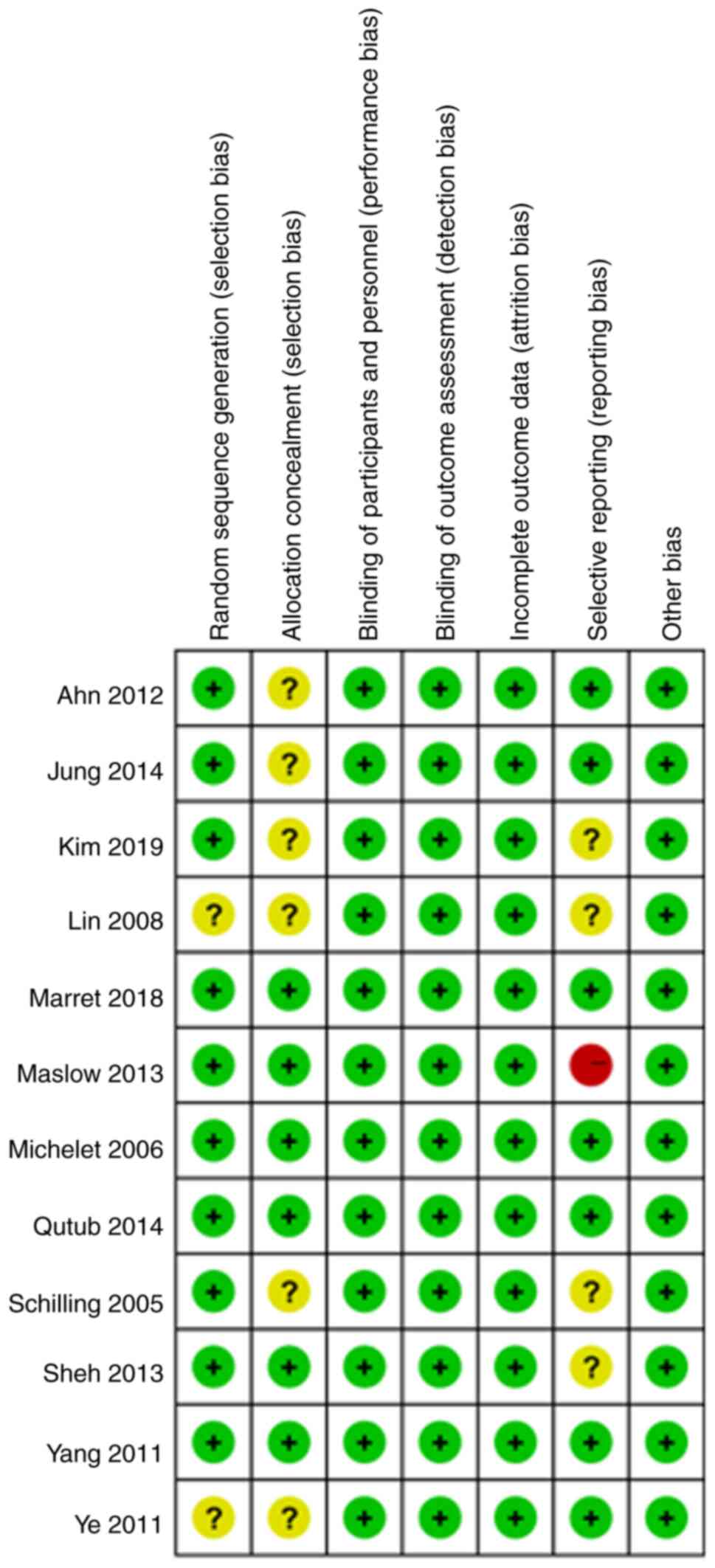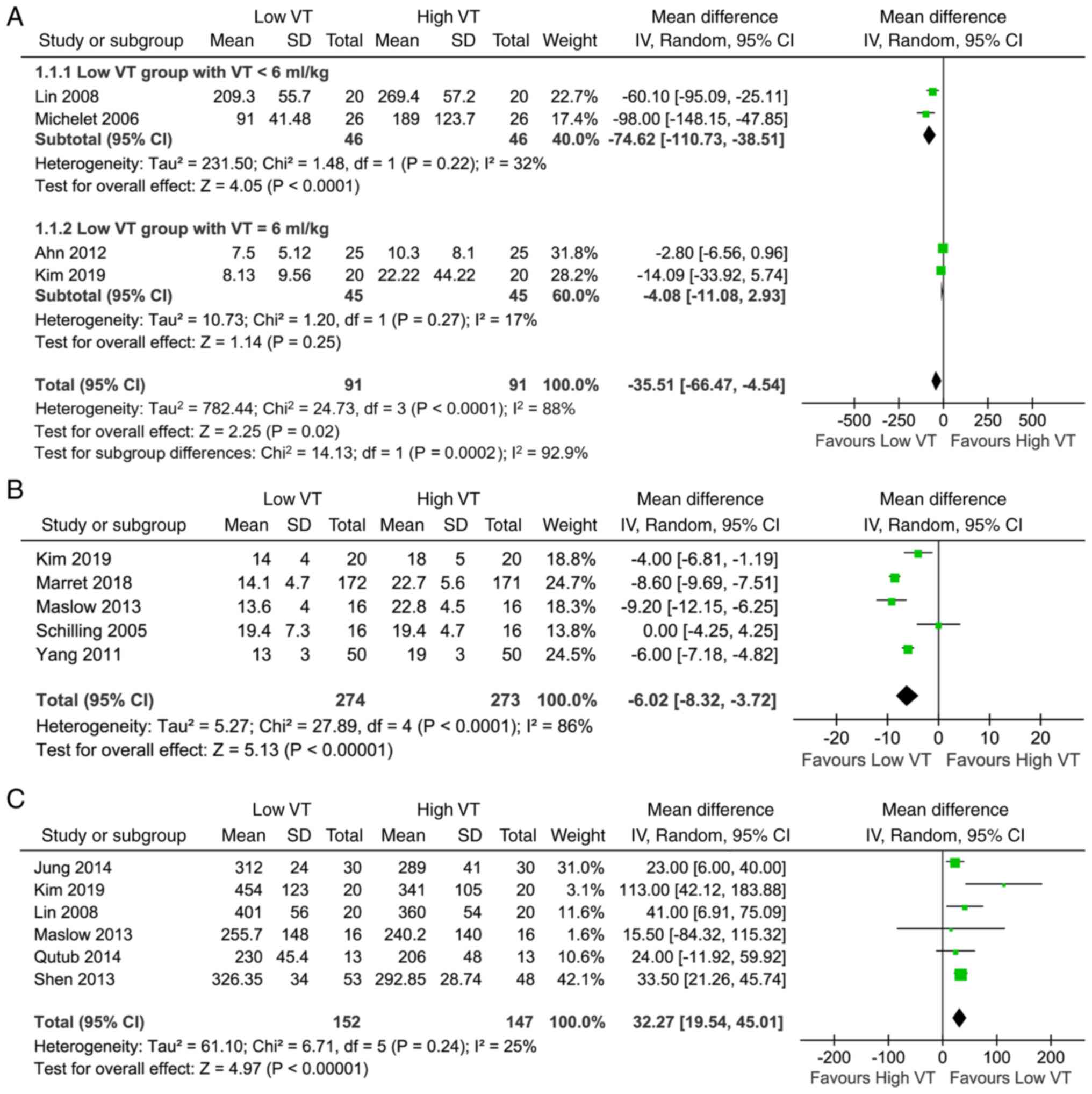|
1
|
Lohser J and Ishikawa S: Clinical
Management of One-Lung Ventilation. In: Principles and Practice of
Anesthesia for Thoracic Surgery. Springer, New York, pp83-101,
2011.
|
|
2
|
Canet J, Gallart L, Gomar C, Paluzie G,
Vallès J, Castillo J, Sabaté S, Mazo V, Briones Z and Sanchis J:
ARISCAT Group. Prediction of postoperative pulmonary complications
in a population-based surgical cohort. Anesthesiology.
113:1338–1350. 2010.PubMed/NCBI View Article : Google Scholar
|
|
3
|
Futier E, Constantin JM, Paugam-Burtz C,
Pascal J, Eurin M, Neuschwander A, Marret E, Beaussier M, Gutton C,
Lefrant JY, et al: A trial of intraoperative low-tidal-volume
ventilation in abdominal surgery. N Engl J Med. 369:428–437.
2013.PubMed/NCBI View Article : Google Scholar
|
|
4
|
Acute Respiratory Distress Syndrome
Network. Brower RG, Matthay MA, Morris A, Schoenfeld D, Thompson BT
and Wheeler A: Ventilation with lower tidal volumes as compared
with traditional tidal volumes for acute lung injury and the acute
respiratory distress syndrome. N Engl J Med. 342:1301–1308.
2000.PubMed/NCBI View Article : Google Scholar
|
|
5
|
Guay J, Ochroch EA and Kopp S:
Intraoperative use of low volume ventilation to decrease
postoperative mortality, mechanical ventilation, lengths of stay
and lung injury in adults without acute lung injury. Cochrane
Database Syst Rev. 7(Cd011151)2018.PubMed/NCBI View Article : Google Scholar
|
|
6
|
Grichnik KP and Shaw A: Update on one-lung
ventilation: The use of continuous positive airway pressure
ventilation and positive end-expiratory pressure
ventilation-clinical application. Curr Opin Anaesthesiol. 22:23–30.
2009.PubMed/NCBI View Article : Google Scholar
|
|
7
|
Della Rocca G and Coccia C: Acute lung
injury in thoracic surgery. Curr Opin Anaesthesiol. 26:40–46.
2013.PubMed/NCBI View Article : Google Scholar
|
|
8
|
Karzai W and Schwarzkopf K: Hypoxemia
during one-lung ventilation: Prediction, prevention, and treatment.
Anesthesiology. 110:1402–1411. 2009.PubMed/NCBI View Article : Google Scholar
|
|
9
|
Kidane B, Choi S, Fortin D, O'Hare T,
Nicolaou G, Badner NH, Inculet RI, Slinger P and Malthaner RA: Use
of lung-protective strategies during one-lung ventilation surgery:
A multi-institutional survey. Ann Transl Med. 6(269)2018.PubMed/NCBI View Article : Google Scholar
|
|
10
|
Peel JK, Funk DJ, Slinger P, Srinathan S
and Kidane B: Positive end-expiratory pressure and recruitment
maneuvers during one-lung ventilation: A systematic review and
meta-analysis. J Thorac Cardiovasc Surg. 160:1112–1122.e3.
2020.PubMed/NCBI View Article : Google Scholar
|
|
11
|
El Tahan MR, Pasin L, Marczin N and
Landoni G: Impact of low tidal volumes during one-lung ventilation.
A meta-analysis of randomized controlled trials. J Cardiothorac
Vasc Anesth. 31:1767–1773. 2017.PubMed/NCBI View Article : Google Scholar
|
|
12
|
Marret E, Cinotti R, Berard L, Piriou V,
Jobard J, Barrucand B, Radu D, Jaber S and Bonnet F: and the PPV
study group. Protective ventilation during anaesthesia reduces
major postoperative complications after lung cancer surgery: A
double-blind randomised controlled trial. Eur J Anaesthesiol.
35:727–735. 2018.PubMed/NCBI View Article : Google Scholar
|
|
13
|
Liberati A, Altman DG, Tetzlaff J, Mulrow
C, Gøtzsche PC, Ioannidis JP, Clarke M, Devereaux PJ, Kleijnen J
and Moher D: The PRISMA statement for reporting systematic reviews
and meta-analyses of studies that evaluate health care
interventions: Explanation and elaboration. PLoS Med.
6(e1000100)2009.PubMed/NCBI View Article : Google Scholar
|
|
14
|
Hozo SP, Djulbegovic B and Hozo I:
Estimating the mean and variance from the median, range, and the
size of a sample. BMC Med Res Methodol. 5(13)2005.PubMed/NCBI View Article : Google Scholar
|
|
15
|
Higgins JP, Altman DG, Gøtzsche PC, Jüni
P, Moher D, Oxman AD, Savovic J, Schulz KF, Weeks L, Sterne JA, et
al: The Cochrane Collaboration's tool for assessing risk of bias in
randomised trials. BMJ. 343(d5928)2011.PubMed/NCBI View Article : Google Scholar
|
|
16
|
Borenstein M, Hedges LV, Higgins JP and
Rothstein HR: A basic introduction to fixed-effect and
random-effects models for meta-analysis. Res Synth Methods.
1:97–111. 2010.PubMed/NCBI View
Article : Google Scholar
|
|
17
|
Higgins JP, Thompson SG, Deeks JJ and
Altman DG: Measuring inconsistency in meta-analyses. BMJ.
327:557–560. 2003.PubMed/NCBI View Article : Google Scholar
|
|
18
|
Ahn HJ, Kim JA, Yang M, Shim WS, Park KJ
and Lee JJ: Comparison between conventional and protective one-lung
ventilation for ventilator-assisted thoracic surgery. Anaesth
Intensive Care. 40:780–788. 2012.PubMed/NCBI View Article : Google Scholar
|
|
19
|
Jung JD, Kim SH, Yu BS and Kim HJ: Effects
of a preemptive alveolar recruitment strategy on arterial
oxygenation during one-lung ventilation with different tidal
volumes in patients with normal pulmonary function test. Korean J
Anesthesiol. 67:96–102. 2014.PubMed/NCBI View Article : Google Scholar
|
|
20
|
Kim HJ, Seo JH, Park KU, Kim YT, Park IK
and Bahk JH: Effect of combining a recruitment maneuver with
protective ventilation on inflammatory responses in video-assisted
thoracoscopic lobectomy: A randomized controlled trial. Surg
Endosc. 33:1403–1411. 2019.PubMed/NCBI View Article : Google Scholar
|
|
21
|
Lin WQ, Lu XY, Cao LH, Wen LL, Bai XH and
Zhong ZJ: Effects of the lung protective ventilatory strategy on
proinflammatory cytokine release during one-lung ventilation. Ai
Zheng. 27:870–873. 2008.PubMed/NCBI(In Chinese).
|
|
22
|
Maslow AD, Stafford TS, Davignon KR and Ng
T: A randomized comparison of different ventilator strategies
during thoracotomy for pulmonary resection. J Thorac Cardiovasc
Surg. 146:38–44. 2013.PubMed/NCBI View Article : Google Scholar
|
|
23
|
Michelet P, D'Journo XB, Roch A, Doddoli
C, Marin V, Papazian L, Decamps I, Bregeon F, Thomas P and Auffray
JP: Protective ventilation influences systemic inflammation after
esophagectomy: A randomized controlled study. Anesthesiology.
105:911–919. 2006.PubMed/NCBI View Article : Google Scholar
|
|
24
|
Qutub H, El-Tahan MR, Mowafi HA, El
Ghoneimy YF, Regal MA and Al Saflan AA: Effect of tidal volume on
extravascular lung water content during one-lung ventilation for
video-assisted thoracoscopic surgery: A randomised, controlled
trial. Eur J Anaesthesiol. 31:466–473. 2014.PubMed/NCBI View Article : Google Scholar
|
|
25
|
Schilling T, Kozian A, Huth C, Buhling F,
Kretzschmar M, Welte T and Hachenberg T: The pulmonary immune
effects of mechanical ventilation in patients undergoing thoracic
surgery. Anesth Analg. 101:957–965. 2005.PubMed/NCBI View Article : Google Scholar
|
|
26
|
Shen Y, Zhong M, Wu W, Wang H, Feng M, Tan
L and Wang Q: The impact of tidal volume on pulmonary complications
following minimally invasive esophagectomy: A randomized and
controlled study. J Thorac Cardiovasc Surg. 146:1267–1273;
discussion 1273-1264. 2013.PubMed/NCBI View Article : Google Scholar
|
|
27
|
Yang M, Ahn HJ, Kim K, Kim JA, Yi CA, Kim
MJ and Kim HJ: Does a protective ventilation strategy reduce the
risk of pulmonary complications after lung cancer surgery?: A
randomized controlled trial. Chest. 139:530–537. 2011.PubMed/NCBI View Article : Google Scholar
|
|
28
|
Ye FF and Li LW: Effects of different
ventilation modes for one-lung ventilation anesthesia on
respiratory function and F(A)/F(I) changes during sevoflurane
inhalation. Nan Fang Yi Ke Da Xue Xue Bao. 31:714–717.
2011.PubMed/NCBI(In Chinese).
|
|
29
|
Hu XY and Du B: Lung-protective
ventilation during one-lung ventilation: Known knowns, and known
unknowns. J Thorac Dis. 11 (Suppl 3):S237–S240. 2019.PubMed/NCBI View Article : Google Scholar
|
|
30
|
Lee JH, Bae JI, Jang YE, Kim EH, Kim HS
and Kim JT: Lung protective ventilation during pulmonary resection
in children: A prospective, single-centre, randomised controlled
trial. Br J Anaesth. 122:692–701. 2019.PubMed/NCBI View Article : Google Scholar
|
|
31
|
Amato MB, Meade MO, Slutsky AS, Brochard
L, Costa EL, Schoenfeld DA, Stewart TE, Briel M, Talmor D, Mercat
A, et al: Driving pressure and survival in the acute respiratory
distress syndrome. N Engl J Med. 372:747–755. 2015.PubMed/NCBI View Article : Google Scholar
|
|
32
|
Neto AS, Hemmes SN, Barbas CS,
Beiderlinden M, Fernandez-Bustamante A, Futier E, Gajic O, El-Tahan
MR, Ghamdi AA, Günay E, et al: Association between driving pressure
and development of postoperative pulmonary complications in
patients undergoing mechanical ventilation for general anaesthesia:
A meta-analysis of individual patient data. Lancet Respir Med.
4:272–280. 2016.PubMed/NCBI View Article : Google Scholar
|
|
33
|
Blank RS, Colquhoun DA, Durieux ME,
Kozower BD, McMurry TL, Bender SP and Naik BI: Management of
one-lung ventilation: Impact of tidal volume on complications after
thoracic surgery. Anesthesiology. 124:1286–1295. 2016.PubMed/NCBI View Article : Google Scholar
|
|
34
|
Park M, Ahn HJ, Kim JA, Yang M, Heo BY,
Choi JW, Kim YR, Lee SH, Jeong H, Choi SJ and Song IS: Driving
pressure during thoracic surgery: A randomized clinical trial.
Anesthesiology. 130:385–393. 2019.PubMed/NCBI View Article : Google Scholar
|
|
35
|
Terragni PP, Del Sorbo L, Mascia L, Urbino
R, Martin EL, Birocco A, Faggiano C, Quintel M, Gattinoni L and
Ranieri VM: Tidal volume lower than 6 ml/kg enhances lung
protection: role of extracorporeal carbon dioxide removal.
Anesthesiology. 111:826–835. 2009.PubMed/NCBI View Article : Google Scholar
|
|
36
|
Dreyfuss D and Rouby JJ: Mechanical
ventilation-induced lung release of cytokines: A key for the future
or pandora's box? Anesthesiology. 101:1–3. 2004.PubMed/NCBI View Article : Google Scholar
|
|
37
|
von Bethmann AN, Brasch F, Nüsing R, Vogt
K, Volk HD, Müller KM, Wendel A and Uhlig S: Hyperventilation
induces release of cytokines from perfused mouse lung. Am J Respir
Crit Care Med. 157:263–272. 1998.PubMed/NCBI View Article : Google Scholar
|
|
38
|
Liu Z, Liu X, Huang Y and Zhao J:
Intraoperative mechanical ventilation strategies in patients
undergoing one-lung ventilation: A meta-analysis. SpringerPlus.
5(1251)2016.PubMed/NCBI View Article : Google Scholar
|
|
39
|
Hedenstierna G and Edmark L: The effects
of anesthesia and muscle paralysis on the respiratory system.
Intensive Care Med. 31:1327–1335. 2005.PubMed/NCBI View Article : Google Scholar
|
|
40
|
Kozian A, Schilling T, Fredén F, Maripuu
E, Röcken C, Strang C, Hachenberg T and Hedenstierna G: One-lung
ventilation induces hyperperfusion and alveolar damage in the
ventilated lung: An experimental study. Br J Anaesth. 100:549–559.
2008.PubMed/NCBI View Article : Google Scholar
|
|
41
|
Östberg E, Thorisson A, Enlund M,
Zetterström H, Hedenstierna G and Edmark L: Positive End-expiratory
pressure alone minimizes atelectasis formation in nonabdominal
surgery: A randomized controlled trial. Anesthesiology.
128:1117–1124. 2018.PubMed/NCBI View Article : Google Scholar
|













